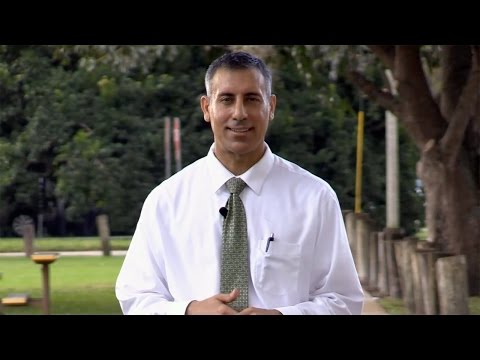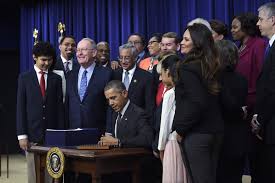
POTUS signs Every Student Succeeds Act
ESSA replaces NCLB, but what does that mean for public education? From the Desk Of takes a closer look.

ESSA replaces NCLB, but what does that mean for public education? From the Desk Of takes a closer look.


(SOURCE: USA TODAY) WASHINGTON — President Obama signed the Every Student Succeeds Act into law Thursday, largely replacing the No Child Left Behind Act that was a hallmark of his predecessor’s domestic agenda.
Lawmakers have touted the new law as a more flexible approach to student testing and school accountability, once again making states responsible for fixing under-performing schools.
Here’s what’s changed in the two laws:
No Child Left Behind:
The Elementary and Secondary Education Act of 1965, signed by President Lyndon Johnson, was a civil rights law that provided education funding to states and attempted to ensure that every student had access to an education. The law would expire every three to five years, requiring Congress to reauthorize it. In 2001, Democrats and Republicans in Congress became increasingly concerned by the growing achievement gaps that left poor and minority students in failing schools, and devised a system of testing and accountability to fix it. “The fundamental principle of this bill is that every child can learn, we expect every child to learn, and you must show us whether or not every child is learning,” President George W. Bush said in the Jan. 8, 2002, signing ceremony.
Every Student Succeeds Act: The new law tries to preserve the spirit of No Child Left Behind, while fixing what were widely perceived as its one-size-fits-all approach. “The goals of No Child Left Behind, the predecessor of this law, were the right ones: High standards. Accountability. Closing the achievement gap,” Obama said Thursday. “But in practice, it often fell short. It didn’t always consider the specific needs of each community. It led to too much testing during classroom time. It often forced schools and school districts into cookie-cutter reforms that didn’t always produce the kinds of results that we wanted to see.”
No Child Left Behind: The law required states to test students on math and English every year in the third through eighth grades, and then again once in high school. It also required at least one science test in elementary, middle and high school.
Every Student Succeeds Act: States must still test students in the same grades but will now have flexibility in how and when they administer those tests. For example, a single annual assessment can be broken down into a series of smaller tests. There’s also an emphasis on finding different kinds of tests that more accurately measure what students are learning.
No Child Left Behind: The 2002 law did not address the Common Core standards specifically, since they didn’t emerge until later that decade. And they emerged not from the federal government, but from a state-led effort to define what the states should be teaching and how it should be taught. But the Obama administration did play a role in expanding Common Core through waivers to No Child Left Behind requirements that encouraged states to adopt the standards.
Every Student Succeeds Act: The new law allows states to adopt Common Core but does not require it. In fact, it requires the Education Department to remain neutral: “The Secretary shall not attempt to influence, incentivize, or coerce State adoption of the Common Core State Standards developed under the Common Core State Standards Initiative or any other academic standards common to a significant number of States, or assessments tied to such standard.”
No Child Left Behind: One of the fundamental principles of the 2002 law — indeed, the principle that gave the law its name — was that schools had to improve the performance of all students. To do that, it required school districts to break out test scores and other measures for minority subgroups to make sure they were making progress each year. In practice, many states found that goal to be unrealistic and got around them by either creating “super subgroups” that lumped all disadvantaged students together, or changing to more subjective measures like parent/teacher involvement.
Every Student Succeeds Act: The new law leaves accountability goals almost entirely up to the states. States must submit their accountability plans to the Department of Education, which still has a limited oversight role. And there are “guardrails” defining broadly what the accountability goals need to include, and test scores and graduation rates must be given “much greater weight” than the more subjective measures.
No Child Left Behind: States that wanted their fair share of federal funding were required to fix schools that failed to improve test scores adequately. Those “interventions” started out with softer measures, but after five years the school had a limited number of dire choices: fire the principal and most of the staff, convert to a charter school, lengthen the school day or year, or close down the school entirely.
Every Student Succeeds Act: The new law is much more specific about which schools need intervention but much less specific on what those interventions should be. Schools at the bottom 5% of assessment scores (as defined by the state), high schools that graduate less than 67% of students, or schools where subgroups are consistently underperforming would be considered failing and could be subject to state takeover — although the law doesn’t say what the state needs to do.
No Child Left Behind: The education law sets policy, and does not spend money directly — that’s done through annual spending bills. The original law authorized up to $32 billion in spending in 2002 dollars, but Congress never spent anywhere close to that, appropriating just $23 billion in 2015.
Every Student Succeeds Act: The law authorizes the spending of $24.9 billion in 2016, again subject to the spending bill now being finalized by Congress. According to the Congressional Budget Office, that cost would grow to $25.8 billion in 2020.
No Child Left Behind: The architects of the 2002 law were on opposite sides of the Capitol and on opposite ends of the political spectrum: Rep. John Boehner, R-Ohio (later the House speaker), and Sen. Ted Kennedy, D-Mass. The vote on final passage was 381-41 in the House and 87-10 in the Senate. Bush signed the bill into law at a high school in Boehner’s congressional district.
Every Student Succeeds Act: The lead sponsors in the Senate were Sens. Lamar Alexander, R-Tenn., and Patty Murray, D-Wash, and in the House were Reps. John Kline, R-Minn., and Bobby Scott, D-Va. It passed the House 359-64 and the Senate 85-12. Obama signed it into law Thursday at the Eisenhower Executive Office Building.
Contributing: Mary Troyan

December 9, 2015
“Passage of the Every Student Succeeds Act is a significant achievement that will better empower Washington state to ensure all students have access to a high-quality education. This legislation removes the outdated and burdensome mandates of No Child Left Behind, and will provide our state with new federal tools to support students, teachers, parents and schools. I was pleased, as chairman of the National Governors Association’s Education & Workforce Committee, to work with Republican and Democratic governors to help advance these critical federal education policy changes.
“Earlier this year our state made historic investments in the full continuum of education, including early learning, K-12, and higher education – investments that will provide greater opportunities for our students and a more competitive economic future for our state. Under ESSA we will be able to more effectively leverage these investments in our classrooms by restoring lost federal funding, enhancing our work on early learning and programs that support at-risk schools and students, and improving our ability to recruit quality teachers.
“I appreciate the support that Washington’s congressional delegation provided for the ESSA. I am especially appreciative of the leadership of Washington Senator Patty Murray, one of the sponsors of the bill, who has fought for years to realize these important reforms.”
Jaime Smith
Governor Inslee’s Communications Office
360.902.4136

Streamed live on Dec 17, 2015
Join Jane Clarenbach, Director of Public Education, and M. Rene Islas, Executive Director for a briefing on the Elementary and Secondary Education Act as reauthorized by the Every Student Succeeds Act. Learn about the implications of the reauthorized law for gifted and talented education.


Originally published by the Pennsylvania Catholic Conference
This week the U.S. House of Representatives passed S. 1177, the Every Student Succeeds Act, and is calling on the Senate to take swift action on the legislation so that it can be signed into law before the end of the year. The White House praised the vote. The bill is poised for a quick vote in the Senate and signed by the president.
The sponsors describe it as bipartisan bill to fix No Child Left Behind (NCLB). The new measure rejects what they call “the overuse of standardized tests and one-size-fits-all mandates on our schools, ensures that our education system will prepare every child to graduate from high school ready for college and careers, and provides more children access to high-quality state preschool programs.” (Fact Sheet: Congress Acts to Fix No Child Left Behind)
Students and educators in non-public schools are cheering the victory as well. There are elements within the bill that improve equitable services to students and teachers in religious and independent schools a long-standing practice that had been eroded under NCLB. It reaffirms that federal education aid should be directed in an equitable way toward helping all children in need, regardless of the type of school they attend.
Different federal programs support local education in many ways. Title I is the biggest federal program that helps students with cognitive and physical disabilities. Title II-D offers continuing education resources to teachers. Title IV helps to create and maintain safe and drug free schools. Once funding streams are more equitable, other federal programs for which non-public school students are eligible will become accessible to them.
How ESSA Benefits Non-Public School Students